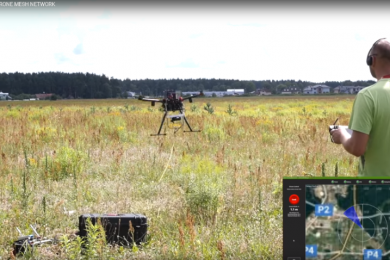With partner UgCS, Rajant has announced the Airmast Tethered Drone System to help mining companies using drones overcome weak or nonexistent communication networks, bolster flight times, improve security, and scale their fleets. Rajant also received a waiver from the Federation Aviation Administration in the US to operate multiple drones at the same time.
Kinetic mesh networks enable the AirMast Tethered Drone System to accomplish more, travel further, communicate with each other, and leverage variable payloads across remote geographies. As the demand for drone usage increases across industry sectors, Rajant’s kinetic mesh networks are equipped to meet the aerial broadband connectivity drones require to maximize business advantage.
Mines and exploration camps, particularly, have been seeking a solution that will enable their drones to overcome weak or nonexistent communication networks.
To address these issues, Rajant and partner UgCS will develop the AirMast Tethered Drone System, which includes UgCS’s ground-based command control software, Rajant’s latest innovation – the BreadCrumb® drone module – and a tether system provided by Elistair.
The Rajant drone module is a light, small-form-factor radio that can be integrated on a single drone or a cluster of drones for fleet management purposes. Capable of handling various payloads, including audio, camera, Lidar (for surveying), chemicals, etc., the light-weight BreadCrumb module integrated on the drone overcomes the obstacles of long distances, flight time and limited functionality.
“Rajant has married the latest innovations in flight with a communication network capable of taking drones greater distances, and for longer periods of time,” said Bob Schena, Chairman and CEO of Rajant. “Drone operators have been faced with weak radio systems and little payload versatility – until now. The AirMast Tether System with our BreadCrumb module gives companies and governments an easy way to establish a broadband network for their drones. With Rajant’s wireless nodes, they have a secure system that can scale with various payloads, giving them true mobility. In kinetic mesh, everything is constantly moving, including the infrastructure, allowing an expansive network footprint.”
UgCS’s ground control software is capable of managing an entire fleet of drones simultaneously, allowing multiple drone operators in the field to connect to a single server. Furthermore, UgCS supports map customization by importing terrain elevation models or map overlays, and maintains simplicity and ease of use through its intuitive 3D interface. UgCS supports the most popular drones and even offers an SDK (software development kit) to create support for custom drone autopilots.
“The AirMast uses an intelligent winch system and a cable that powers the drone from the ground, allowing it to stay in the air for extended periods of time with no reliance on batteries,” said Janis Kuze, Sales Director at UgCS. “Paired with a Rajant BreadCrumb drone module, it can quickly deploy a network ‘tower’ for as long as necessary, all the while being mobile, too. Together with UgCS, this setup allows for the deployment and management of a mesh network of drones. In addition, flight data as well as video streams from multiple drone operators in the field can be quickly sent to a UgCS ground station operator, allowing him or her to scan a large area in a short amount of time using drones, something that is very useful for search and rescue operations, photogrammetry and other fields.”










